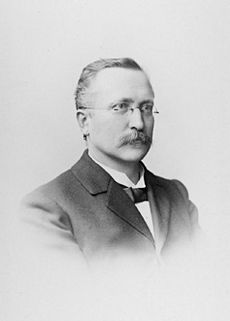Wilhelm Roux facts for kids
Quick facts for kids
Wilhelm Roux
|
|
|---|---|

Wilhelm Roux
|
|
| Born | 9 June 1850 |
| Died | 15 September 1924 (aged 74) |
| Nationality | German |
| Alma mater | Jena, Strasbourg, Berlin |
| Known for | Mosaic theory of ontogeny |
| Scientific career | |
| Fields | Zoology, anatomy embryology, cell biology |
Wilhelm Roux was an important German scientist who lived from 1850 to 1924. He was a zoologist, which means he studied animals. He was also a pioneer in experimental embryology. This field looks at how living things develop from tiny beginnings. Roux is famous for his work on how embryos grow and form different parts.
Contents
Early Life and Education
Wilhelm Roux was born in Jena, Germany. He went to university there and studied with a famous scientist named Ernst Haeckel. Roux also studied at universities in Berlin and Strasbourg. There, he learned from other important scientists like Gustav Albert Schwalbe, Friedrich Daniel von Recklinghausen, and Rudolf Virchow. Even though he trained to be a doctor, he spent his career doing experiments in biology. His early research looked at how blood vessels develop in embryos. This was a big step in understanding the body's systems.
Career and Scientific Discoveries
For ten years, Roux worked in Breslau, which is now called Wroclaw. In 1879, he became the head of his own Institute of Embryology. Later, he became a professor in Innsbruck, Austria, from 1889 to 1895. After that, he taught at the University of Halle until 1921.
Understanding How Organisms Develop
Roux's main idea was called Entwicklungsmechanik, or "developmental mechanics." He wanted to understand the exact ways that living things develop. He studied how bones, cartilage, and tendons change to adapt to problems or diseases. His method was to gently change developing embryos and then watch what happened.
Roux mostly used frog eggs for his experiments. He wanted to see how the very first structures in amphibians formed. His goal was to show how Darwin's ideas about evolution worked at the level of tiny cells.
The Role of Chromosomes
Around the same time, scientists rediscovered the work of Gregor Mendel. Mendel had shown that living things pass on traits through "heritable elements." Roux's work, combined with Mendel's, showed how important chromosomes are. Chromosomes carry the information that tells a cell what to become. When a cell divides, it makes two new cells. Each new cell gets the same number of chromosomes as the original cell.
Pioneering Tissue Culture
In 1885, Roux did an amazing experiment. He took a small piece of tissue from a developing chicken embryo. He kept this tissue alive in a warm salt solution for 13 days. This was one of the first times anyone had kept living tissue growing outside of a body. This idea later became known as tissue culture. It was a very important step for future scientists like Ross Granville Harrison and Paul Alfred Weiss.
Roux's "Mosaic" Theory
In 1888, Roux did another famous experiment with frog embryos. He took embryos that had only 2 or 4 cells. He then used a hot needle to kill half of the cells in each embryo. He saw that these damaged embryos grew into only half-embryos.
From this, Roux thought that each cell in an early embryo already had a specific job. He believed that after just a few cell divisions, the embryo was like a mosaic. In a mosaic, each tiny piece has its own unique place and helps create the whole picture. This idea was called his "Mosaic" theory of epigenesis.
Later Discoveries and Legacy
A few years later, other scientists, like Hans Driesch and Hans Spemann, did more experiments. They found that Roux's "mosaic" theory wasn't always correct. They showed that early embryo cells could often still develop into a whole organism, even if some cells were removed.
However, even though his specific theory was later updated, Roux's way of doing science was very important. His method of experimenting with embryos and observing the results helped shape how biology was studied in the 20th century. He showed that by carefully changing things, scientists could learn how life develops.
Works
- Der Kampf der Teile im Organismus (1881)
- Beiträge zur Entwinckelungsmechanik des Embryo (1885)
- Über die Entwicklungsmechanik der Organismen (1890)
- Geschichtliche Abhandlung über Entwicklungsmechanik (two volumes, 1895)
- (in de) Gesammelte Abhandlungen über Entwickelungsmechanik der Organismen. Leipzig: Wilhelm Engelmann. 1895. https://gutenberg.beic.it/webclient/DeliveryManager?pid=12323608.
- (in de) Über die Bedeutung geringer Verschiedenheiten der relativen Grösse der Furchungszellen für den Charakter des Furchungsschemas. Halle: Carl August Schwetschke. 1896. https://gutenberg.beic.it/webclient/DeliveryManager?pid=12417319.
- Die Entwicklungsmechanik (1905)
- Terminologie der Entwicklungsmechanik (1912).
See also
 In Spanish: Wilhelm Roux para niños
In Spanish: Wilhelm Roux para niños
Images for kids


